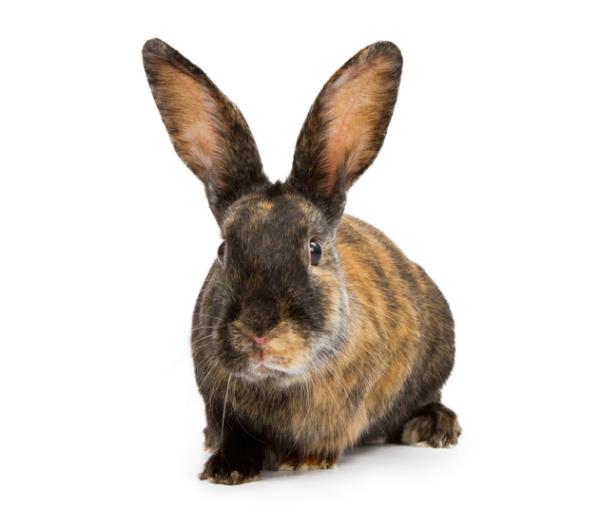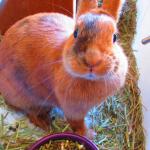Harlequin Rabbit

At AnimalWised, we are always adding to our animal breed files to help you understand more about the companion animals we love so much. With their popularity increasing all the time, we get to hear about new breeds as they develop. The Harlequin rabbit is not one of these. In fact, this breed dates back to the 19th century. They are known for a particular characteristic, something which can be determined from their photo.
We tell you everything you need to know about the Harlequin rabbit. We explain their origin, their history, their appearance and, most importantly for you, the care they need to be happy and healthy.
- Europe
- France
Origin of the harlequin rabbit
The origin of the Harlequin rabbit lies in France. Although the exact year they first appeared is unknown, it is suspected that it was sometime during the 1880s. The breed arose from a crossing of local wild rabbits with semi-wild Ditch rabbits. By 1887, the first exhibition had already been held in France during a Paris exhibit. Their popularity grew so much they quickly reached England and arrived in the USA by 1920.
A curious fact about the history of the Harlequin rabbit is that they were previously known as the Japanese rabbit before the First World War. By WWII, they had become known as the Harlequin rabbit. However, their previous moniker is used in some degree, as you will see below.
If you want to know more about other French rabbit breeds, you can check out our breed file on the Blanc de Hotot rabbit.
Harlequin rabbit characteristics
Harlequin rabbits usually weigh between 2.7 and 3.6 kg (5.9 - 7.9 lbs) once they reach adulthood. It should be noted that males are normally smaller than females. The body of these rabbits is compact and rather elongated, with medium-sized legs. They have developed musculature, which gives them great physical power. The head is proportionally larger than the body, with ears that rise upward and end in rounded tips.
The Harlequin rabbit has a short coat which should display great shine and be silky smooth. This coat is straight and covers the entire body evenly. The most characteristic aspect of this rabbit breed is their coat color patterns and markings.
Harlequin rabbit coat colors
Despite there being a great variety of coat patterns, there are two types of fur which are distinguished in the harlequin rabbit:
- Magpie: white base mixed with blue, black, chocolate or lilac. These patches are in the form of bands, bars or a mixture of both.
- Japanese: with an orange base and combinations of chocolate, lilac, blue or black.
Harlequin rabbit character
Although the Harlequin rabbit may be prized for their distinct coat, they are treasured for their benevolent and affectionate character. Harlequins are bunnies who exude charm and a pacific nature. They can be extremely sensitive, so we remind guardians to be cautious if they live in a home with other animals such as cats or dogs. This can easily lead to stress in the Harlequin.
In general, we can highlight this rabbit's good nature and ease of living at home. They are a rabbit which will need more attention than some other breeds. It is best to keep them inside the home rather than an outdoor hutch as they do not well tolerate solitude. Although they will bond strongly with their human family, they do not fare well with other companion animals.
Although the Harlequin rabbit stands out for their loving and friendly character, this does not mean they aren't territorial. Rabbits are territorial animals in general, marking territory and becoming defensive if they feel their home is under attack. These feelings of territoriality can be exacerbated during their ‘heat period’ (technically not the same as other animal's heat period, but the time they are most fertile nonetheless). For this reason and more, it is recommended that the Harelquin rabbit is sterilized.
We explain further in our article on general tips for rabbit care.
Harlequin rabbit care
The care of the Harlequin rabbit does not differ from the general care that any domestic rabbit should receive. For example, regular brushing of their fur is recommended to remove dust and dirt. Bathing them is not recommended, except when they are exceptionally dirty or have toxic substances on their coat.
In terms of their diet, the Harlequin, like any rabbit, has an exclusively herbivorous diet. They can only consume foods of plant origin. Specifically, their diet must be based on the consumption of hay, vegetables and fresh fruit. They must also always have water at their disposal to stay properly hydrated.
The Harlequin rabbit must also be provided with a suitable hutch. This is one which is wide and allows full mobility for the rabbit. There must also be a soft bed provided within the hutch, but it should be made from suitable material, so check before you buy. They will also need a water bottle, food dish and teething toys to gnaw on. Since a rabbit's teeth never stop growing, without chewing toys, rabbits can develop abnormal teeth growth.
For at least part of the day, a Harlequin rabbit must be given freedom of movement. This means a large hutch is insufficient. They will need either a rabbit run or to be given free reign within an area of the home. If the latter is possible, we need to make it safe for the rabbit to roam. This means removing electric cables, preventing other pets from entering and not letting them be able to escape.
Harlequin rabbit health
The Harlequin rabbit, like any other domestic rabbit, can suffer a number of diseases that cause discomfort and/or pain. One of them is the aforementioned abnormal teeth growth. If their teeth are not properly cared for, it can result in the teeth penetrating their flesh, secondary bacterial information and an inability to eat food. The latter alone is fatal if not treated. To avoid this, provide them with toys, endless supplies of hay and a happy environment. If we see the rabbit does stop eating, it could be due to a dental abscess or malocclusion.
In addition to their teeth, we also need to keep their nails, eyes and ears in good condition. Check for mites or any other possible parasites. Regularly clean their ears, trim their nails if necessary and observe for any redness in their eyes. If they receive all the care they need, the Harlequin rabbit life expectancy ranges between 6 and 8 years.
Harlequin rabbit for adoption
The harlequin rabbit is a relatively common rabbit, so we can usually adopt with relative ease. This will depend on where you live and availability. As always, at AnimalWised we recommend a responsible adoption. This means taking into account the needs of these animals and being very aware of what adopting them implies. We must be sure that we can take charge of their care and that we will be able to provide them with everything they need for a full and happy life.
Once the decision is made, how do you adopt a Harlequin rabbit? The first thing you need to do is to go to your closest animal shelter which houses exotic pets and enquire within. Even if they don't have any Harlequin rabbits, they can recommend a reputable breeder. However, we would recommend you adopt any rabbit from a shelter if you are able.
Vídeo de Harlequin Rabbit
Harlequin Rabbit photos



















